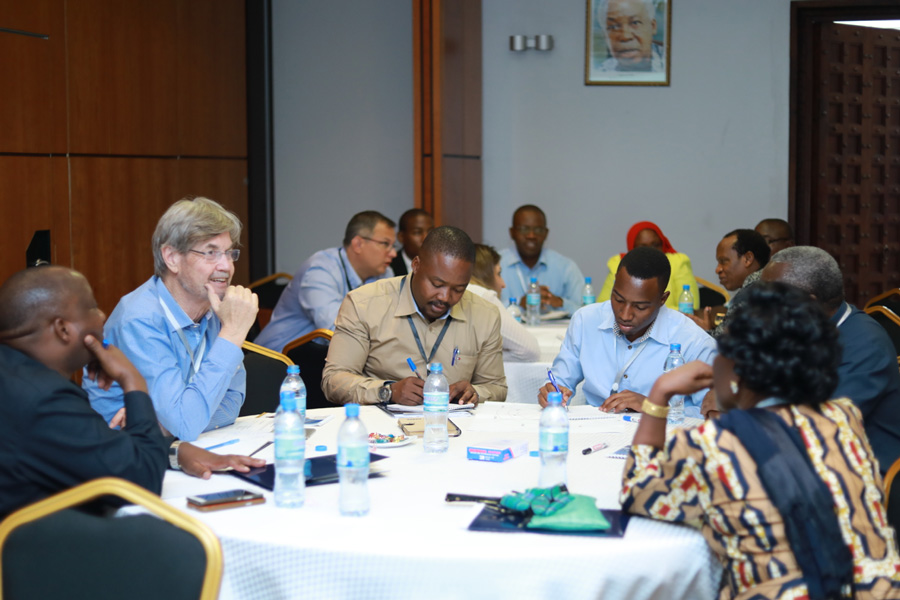Tokyo is currently the largest city in the world but by 2050 it may drop to seventh place, surpassed by fast-growing cities such as Kinshasa and Lagos. For Murray Metcalfe (MIE) this explosive growth presents both a challenge and an opportunity for engineers.
“We were inspired by a study published by our collaborator Dan Hoornweg, which predicts that by 2100, 13 of the largest 20 cities in the world will be in sub-Saharan Africa,” he says. “The challenge is: how do you build enough infrastructure to support cities of this size? The opportunity is: can that infrastructure be sustainable?”
Metcalfe is the project director of the Engineering Education for Sustainable Cities in Africa (EESC-A) project, which began in 2016. The goal of EESC-A is to explore U of T Engineering’s role in helping to train future “sustainable cities engineers” who will shape the direction of African megacities of the future.
The project involves both community building and the creation of flexible, adaptable course materials that can be delivered online. Over the years, the team has included Hoornweg and post-doctoral researcher Dr. Nadine Ibrahim, now the Turkstra Chair in Urban Engineering at the University of Waterloo. Other key contributors include senior researcher and project coordinator Dr. Rahim Rezaie, civil engineering PhD candidate Chibulu Luo, and a large number of graduate students, undergrads, and scholars across the world, including in Nigeria, South Africa, Tanzania and Zambia.
The Toronto-based EESC-A team members travel frequently to various African countries to build and maintain a network of institutions and academics with expertise in sustainable cities. Collectively, they have visited about 30 engineering schools in 10 countries since 2016. The program has also funded four African “roaming scholars” to travel within the continent, further strengthening these bonds through interactions and collaboration. The roaming scholars are:
- David Olukanni, Professor in Water Resources and Environmental Engineering in the Civil Engineering Department at Covenant University, Nigeria.
- Gilbert Siame, founder and director of the Centre for Urban Research & Planning (CURP) at the University of Zambia.
- Innocent Musonda, Associate Professor and founding director of the Centre for Applied Research & Innovation in the Built Environment (CARINBE) at the University of Johannesburg.
- Fatma Mohamed, head of the Structural and Construction Engineering Department at the University of Dar es Salaam in Tanzania.
Last fall, three of these four scholars — along with their students — participated in a project known as the Global Classroom, through which an online course developed by Ibrahim was delivered simultaneously across multiple institutions. Students would step through the content with their respective professors, then meet once a week via videoconference with the entire team.
“At some schools, the students assembled together in a classroom but in others, due to time zone differences, they’d be in their homes, maybe even in their cars,” says Metcalfe. “Each time, we were able to have a robust discussion about the material and how it applied to the individual cities where the students lived.”
The team has received very positive feedback about the first iteration of the course which was run as a not-for-credit trial. Future online courses may offer full course credit, either at U of T or the partner institutions.
“We have seen a number of cases in Africa where online education strategies are successfully used to enhance access,” says Rezaie. “This is area is ripe for further development and could be an effective way for institutions such as U of T to contribute to the continent’s development by directly engaging with African scholars and students.”
In the meantime, a successful EESC-A Workshop in Livingstone, Zambia last summer drew senior African engineering educators from multiple countries. Last month, Luo spent time in Rwanda as a visiting scholar at the African Leadership University, which recently opened a new campus in Kigali. She attended several classes on sustainable engineering and delivered lectures on her field research on low-carbon energy pathways in Tanzania and Zambia.
Rezaie and Metcalfe are also collaborators on another project, known as the Virtual Global Engineering Classrooms (V-GET). V-GET, led by Professor Elham Marzi (ISTEP), will leverage some of the lessons of EESC-A to expose U of T Engineering students to global perspectives within their courses. Through V-GET, teams made up of students from U of T Engineering and other international institutions will collaborate virtually on design projects.
While there are many benefits for U of T Engineering student to this type of international collaboration, Metcalfe emphasizes that the focus of EESC-A remains on Africa.
“From the beginning, we’ve been clear that the solutions to the challenge of making Africa’s rapidly-growing cities sustainable will come from African scholars, practitioners, and decision-makers,” he says. “Our hope is that the model we’ve created offers a mutually beneficial partnership that can help avoid some of the mistakes we’ve made in Western cities, while sharing new insights that can lead to the great African city of the 21st century.”




